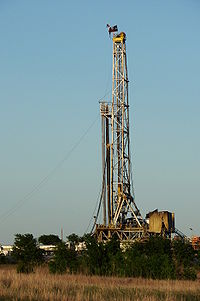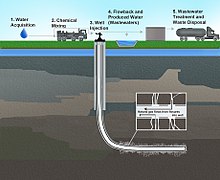
| Fracking |
|---|
 |
| By country |
| Environmental impact |
| Regulation |
| Technology |
| Politics |

Fracking in the United States began in 1949.[1] According to the Department of Energy (DOE), by 2013 at least two million oil and gas wells in the US had been hydraulically fractured, and that of new wells being drilled, up to 95% are hydraulically fractured. The output from these wells makes up 43% of the oil production and 67% of the natural gas production in the United States.[2] Environmental safety and health concerns about hydraulic fracturing emerged in the 1980s, and are still being debated at the state and federal levels.[3][4][5]
New York banned massive hydraulic fracturing by executive order in 2010, so all natural gas production in the state is from wells drilled prior to the ban.[6] Vermont, which has no known frackable gas reserves, banned fracking preventatively in May 2012. In March 2017, Maryland became the second state in the US with proven gas reserves to pass a law banning fracking.[7] On May 8, 2019, Washington became the fourth state to ban fracking when Governor Jay Inslee signed SB 5145 into law after it passed the State Senate by a vote of 29-18 and the House 61–37. Washington is a non-oil and gas state that had no fracking operations when the bill was passed.[8][9]
An imbalance in the supply-demand dynamics for the oil and gas produced by hydraulic fracturing in the Permian Basin of west Texas is an increasing challenge for the local industry, as well as a growing impact to the environment. In 2018, so much excess natural gas was produced with oil that prices turned negative and wasteful flaring increased to a record 400 million cubic feet per day.[10] By Q3 of 2019, the wasted gas from this region alone almost doubled to 750 million cubic feet per day,[11] an amount more than capable of supplying the entire residential needs of the state.[12]
- ^ Cite error: The named reference
Montgomerywas invoked but never defined (see the help page). - ^ How is shale gas produced? (PDF) (Report). US Dept. of Energy. April 2013.
- ^ Marie Cusick (August 27, 2013). "DEP Attempted To Suppress Controversial Study That Criticized Shale Gas". State Impact Pennsylvania. National Public Radio (NPR) Member Stations. Retrieved October 19, 2013.
- ^ Urbina, Ian (August 3, 2011). "A Tainted Water Well, and Concern There May be More". The New York Times. Retrieved February 22, 2012.
- ^
- Fox, Josh (June 18, 2010). "New Film Investigates 'Fracking' For Natural Gas". Science Friday (Interview). Interviewed by Ira Flatow. Washington, D.C.: WAMU. Retrieved June 21, 2010.
- Margot Roosevelt (June 18, 2010). "Gulf oil spill worsens – but what about the safety of gas fracking?". LA Times. Retrieved June 21, 2010.
- "EPA Announces a Schedule of Public Meetings on Hydraulic Fracturing Research Study". United States Environmental Protection Agency. June 21, 2010. Retrieved June 21, 2010.
- "FracTracker's Mapping Tool". March 17, 2011. Retrieved October 6, 2012.
- "APNewsBreak: EPA theorizes fracking-pollution link". United States Environmental Protection Agency. December 8, 2011. Retrieved December 9, 2011.
- ^ "Utica Shale Play" (PDF). April 2017. p. 7. Retrieved September 18, 2020.
Because of the recent ban on hydraulic fracturing in New York, natural gas production in New York state is from wells drilled prior to the ban in 2010.
- ^ Pamela Wood (March 27, 2017). "Maryland General Assembly approves fracking ban". The Baltimore Sun. Archived from the original on April 1, 2017. Retrieved April 1, 2017.
- ^ "Fracking in Washington". Ballotpedia. Retrieved June 14, 2019.
- ^ "SB 5145 - 2019-20". Washington State Legislature. Retrieved June 14, 2019.
- ^ Scott DiSavino (May 22, 2019). "U.S. natural gas prices turn negative in Texas Permian shale again". Yahoo Finance.
- ^ Nick Cunningham (December 14, 2019). "Emissions Soar As Permian Flaring Frenzy Breaks New Records". Oilprice.com.
- ^ Kevin Crowley and Ryan Collins (April 10, 2019). "Oil Producers Are Burning Enough 'Waste' Gas to Power Every Home in Texas". Bloomberg News.